An Introduction to the Early Two and a Half Dollar Gold Pieces
Written by:By Bill Jones
All material and images owned by Bill Jones
Back in 1960 when I was just starting to push Lincoln Cents into my Whitman penny folders, I was very surprised when my mother told that she had seen two and a half dollar gold pieces when she was child. That denomination seemed weird to me because there was no paper money equivalent to it. Of course to all 19th century Americans and to the first generations of the 20th century, the two and a half dollar gold coin or quarter eagle was as ordinary as a silver dollar or the other gold denominations of that era. One didn’t see those coins every day because they did not circulate that much, but everyone was aware that they existed.
Although a $2.50 coin may seem odd today it was actually a logical extension of our monetary system. The Coinage Act of 1792 created a hybrid of the decimal money system, which the United States introduced, and the Spanish system of “bits” or “eighths” of a dollar that the United States inherited. The major silver unit or dollar was divided into subsidiary parts, which included the half-dollar or “four bits” and the quarter-dollar or “two bits.”
Similarly the ten dollar gold piece or “eagle,” which was the major gold unit, was divided into its half eagle and quarter eagle parts.
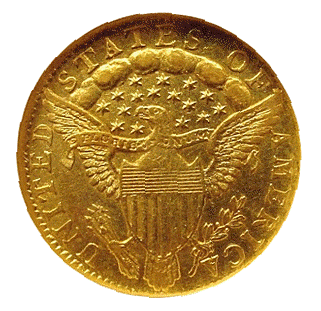
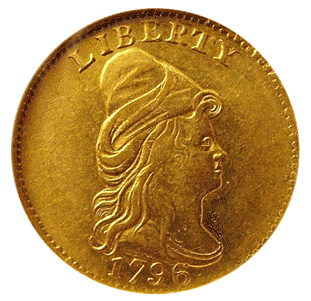 The U.S. Mint issued the first quarter eagles in 1796.
The U.S. Mint issued the first quarter eagles in 1796.
Those coins featured a bust of Ms. Liberty wearing a hat and hairstyle that was the latest fashion of the time. The reverse featured a heraldic eagle that would become the standard design for all U.S. gold and silver coins by the year 1800. The very first quarter eagles had no stars on the obverse, which was an unusual feature. All of the other U.S. gold and silver coins had stars on the obverse, and designer Robert Scott quickly changed that when he made the second quarter eagle obverse die later that year. With a mintage of only 963 pieces the 1796 “no stars” quarter eagle is a rare coin, but the “with stars” is even rarer with a smaller mintage of only 432. Still the “no stars” variety is a one year type coin that sells for higher prices that the “with stars” piece.
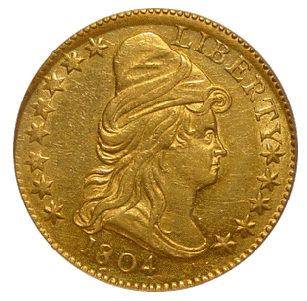
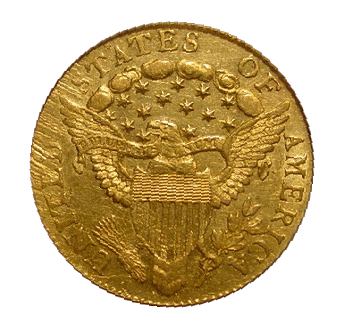
The Capped Bust Right Quarter Eagles were issued for most years from 1796 to 1807, but they would never be minted in very large quantities. Back in the early days of the Philadelphia Mint banks, businesses and wealthy individuals were encouraged to deposit gold and silver for coinage into United States currency. Since these depositors could specify the denominations they wanted, the coins of choice were the silver dollar and the five and ten dollar gold pieces. These demands were heavily influenced by the fact that the larger coins were more convenient to use in large transactions, such as payments for purchases overseas.
The dime sized quarter eagles were ordered largely on a whim according to the late numismatic authority, Walter Breen. The most frequent requests for them came from two Philadelphia banks, the Bank of Pennsylvania and the Bank of the United States. Since most of these early coins are usually in VF to AU, it would appear that these coins spent a fair amount in bank vaults and comparatively little time in people’s pockets and purses. These coins were also popular for use as jewelry, and more than a few of these pieces have been salvaged from loops and broaches. Although one must be careful examine these pieces for evidence of jewelry use, pieces that show such problems are still quite valuable because the coins are so scarce.
It was no accident that the diameters of the early gold coins coincided with those of certain silver pieces. The similarity in size between the dime and quarter eagle, the quarter and the half eagle and the half-dollar and the eagle made it possible for the mint to use some of its tools interchangeably. Interestingly enough the only known instances in which two denominations shared the same die have been found between the dime and the quarter eagle. There are varieties of 1800, 1802, 1803, 1804 and 1807 dimes that share a reverse with varieties of quarter eagles.
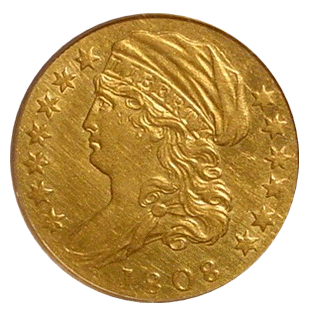
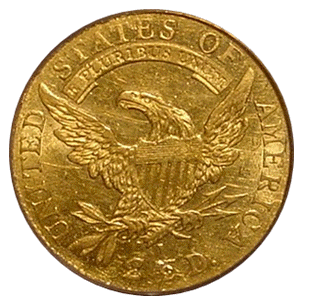
In 1808 newly hired mint engraver, John Reich, redesigned the quarter eagle as a part of his assignment to replace every coin design that was then in production at the first U.S. mint. Reich’s design featured a buxom wench, who his detractors claimed was patterned after “his fat mistress.” Unlike the other designs that he created, Reich’s Capped Bust quarter eagle was produced for only year. That resulted in the creation of the rarest type coin in the United States series. Only 2,710, 1808 quarter eagles were struck. John Dannreuther, who co-wrote the book Early U.S. Coin Varieties, estimates that only 125 to 150, 1808 quarter eagles exist in all grades. Among type collectors and gold coin enthusiasts, acquiring an 1808 quarter eagle is a numismatic milestone.
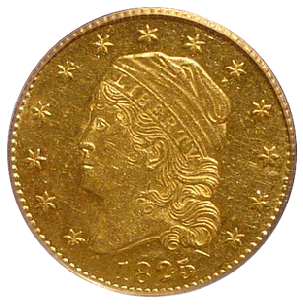
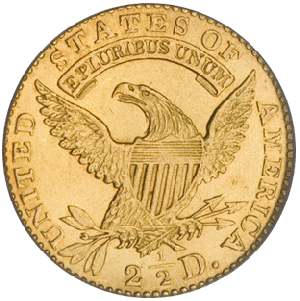
The Mint did not issue any quarter eagles from 1809 to 1820. In 1821 the quarter eagle reappeared with a design that Reich had created for the half eagle in 1813. By this time Reich had left the mint, and chief mint engraver. Robert Scott, who was 77 years old and well past his prime, cut the dies from Reich's design. This depiction of Ms. Liberty was a very matronly lady, depicted in low relief with a stout face and blunt features. Once more the annual mintages were small.

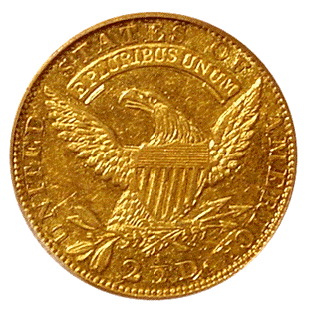
Some collectors and dealers call these early U.S. gold coins “the fatty $5 and fatty two and half dollar” gold pieces. In 1829 the mint modified its production procedures for the quarter eagle by introducing the close collar to the denomination. In the past the edge reeding had been applied to the coin in a separate operation. Starting in 1829 the blank planchets were dropped in a collar and the reeding was squeezed on the coin at the same as it was struck. This change eliminated a step in the coining process and gave the finished coins a more uniform diameter. The closed collar coin dies, which were created by mint engraver, William Kneass, differed slightly from the open collar pieces. Most collectors recognize them as a separate type. Once more the mintages were very low; the coins are very scarce; and they almost neverseen in circulation. In fact, they were most frequently used to pay members of Congress who demanded that they receive their salaries in gold.
By 1834, the United States gold coins were in the doldrums. The melt value of the coins exceeded their face value and the coins received little use as a result. But change was in the wind. Andrew Jackson had been elected to a second term as President, and he was posed to enact his own version of monetary reform.

